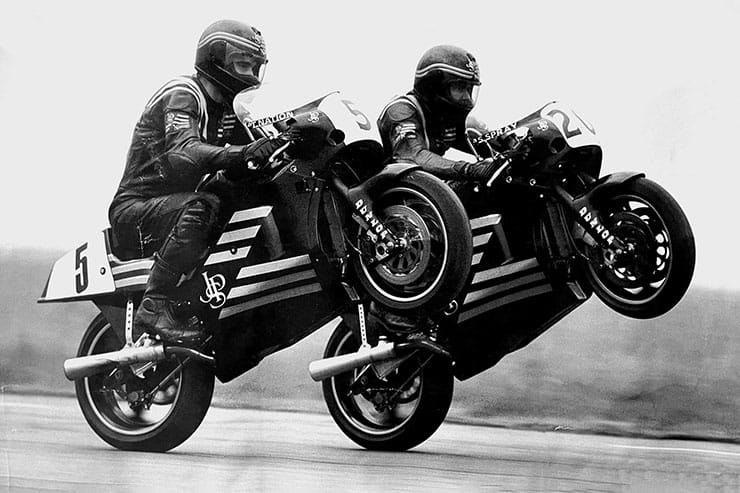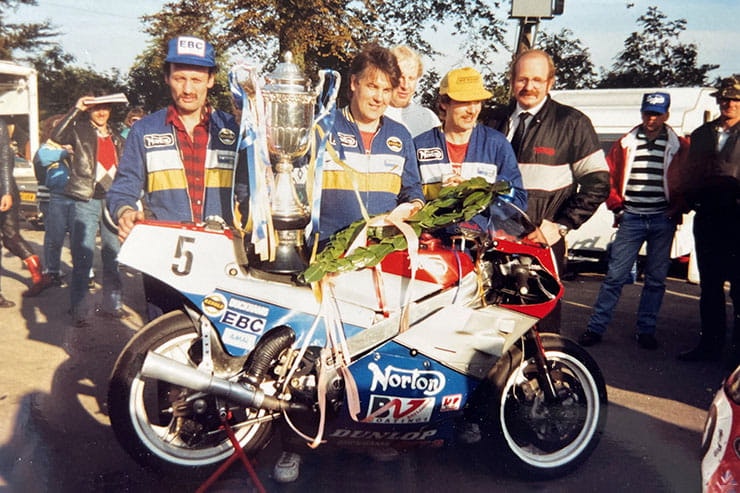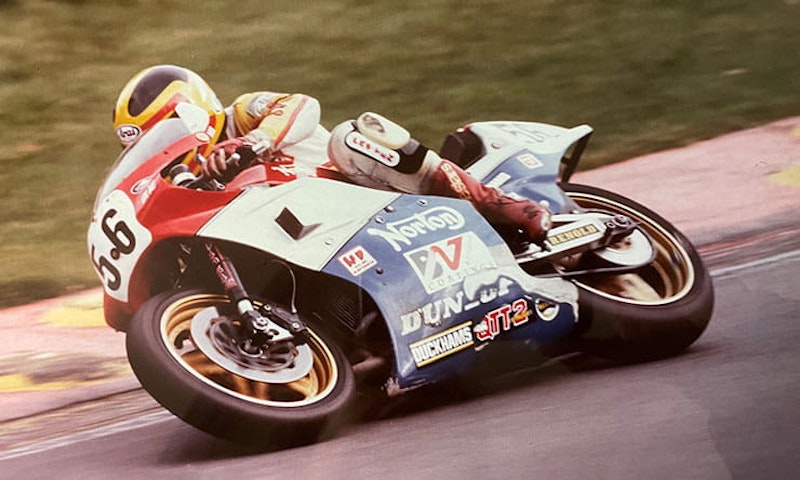Brian Crighton: the Rotary Man’s story
By Michael Mann
BikeSocial Managing Editor. Content man - reviewer, road tester, video presenter, interviewer, commissioner, organiser. First ride was a 1979 Honda ST70 in the back garden aged 6. Not too shabby on track, loves a sportsbike, worries about helmet hair, occasionally plays golf and squash but enjoys being a father to a 7-year old the most.
08.09.2022
Mention Norton race bikes of the late 80s, mutter the words ‘rotary engines’, or even the new 95-grand Crighton CR700W track bike, and one name, one man stands out as the connection; Brian Crighton, the 74-year-old British engineer whose lifetime has been dedicated to developing motorcycle engines of all shapes and sizes.
But did you know that Mr Crighton was three-times British 50cc champion in the mid-70s? In those days his feverish addiction to 4-stroke engines but a limited budget resulted in him fettling road bikes to compete on instead of race bikes. Those engineering foundations led to the rotary-engineed Norton race bikes of the late 80s/early 90s, and later, the fascinating modern-day CR700W.
But did this softly spoken genius study engineering? “Not really no, it was self-taught. I could never afford a proper racing bike, so I had to have a road bike and modify it and I ended up beating the proper bikes! I did an awful lot of work with 4-strokes and I really went into it deeply to fully understand it, so I was into engines,” he told BikeSocial in a recent interview. The very same day on which the fruits of his last five years was being handed over to me, at Cadwell Park during a Bennetts Track Day.
An ultra-exclusive track bike for those willing to part with £95,000 + VAT as a starting price depending on the customer’s specification; “Bitubo or Ohlins sir/madam? And would you like a quickshifter with that?” It’s guaranteed to win inters… if you can persuade circuit bosses that it’s quieter when running than static.
The CR700W boasts an extraordinary power-to-weight ratio with a claimed power figures of 220hp at 10,500rpm (200 at the wheel), 142Nm of torque at 9,500rpm plus a dry weight (matching the GP 500 2-strokes of yesteryear, Brian’s inspiration) of just 130kg! Never mind GP500s, the 1.68hp per kg is more akin to a modern-day MotoGP monster.
Check the full Crighton CR700W review here
But how did Brian Crighton end up building those Norton race bikes, thirty-five years ago?
“I was a motorcycle dealer years and years ago, with a Honda dealership. And my friend of mine who’d also got a dealership left that and got a job at Norton. At the time they were doing prototypes, and he came to me and said, “have a go on this prototype”, so I went on it and I thought blimey, this is fantastic, so smooth and so fast. I thought ‘bloody hell, you’re going to have to get a job here’ because I was into engines anyway.”
What happened next was a show of will and an eagerness continue learning how the engines worked but at the same time, to demonstrate how he could use his experience to make them even better… but did his new employers listen?
“I thought this would make a fantastic race bike, so I got taken on in the service department and I looked after the demonstrators for the police and the RAC. And I thought they’ve got to let me have a go, and I kept saying ‘I’m sure I can get more power out of this engine’, because they were about 86 horsepower was the maximum they had at the time. There was a crashed police bike in the corner that had been there for a long time so I kept bothering them about using the bike, I was sure I could get 120 horsepower out of the engine.
“So, in my own time at night, I worked on this engine and the first time we put it on the dyno it made 120 horsepower, like I said! So I begged them for the rest of the bike to turn it into a hack and take it MIRA (the testing ground). They let me have the rest of the police bike and I cut the back end off and put some tubes on because it was like a pressed frame on that bike at the time. This was at Norton with my own tools and at my cost.
How fast did it go?
“I modified it and took it MIRA and it did 170mph! We had a policeman and a radar gun... funnily enough the person who was in charge at MIRA told us ‘When you’re going ‘round just be very, very careful because we have some very fast Jaguars so when you get to the corners just look ‘round to make sure you’re alright’. So the test rider went off on this bike and he came <whoosh> down one of the straights and the policeman, shocked, said, ‘170mph… I’ve never my radar gun this high!’. And the manager of the place said, ‘Blood and sands! I’d better get these slow Jaguars off the circuit’.
Above: Mann and Crighton chat at Cadwell
It beat the Jaguars but did Mr Crighton stop there? Of course not…
“This was in 1986, and this was quite fast for a 588cc bike. Then I said, ‘can I make a proper race bike?’
“But they wouldn’t let me so after all that I got fed up, spat my dummy out and left. But because I was into the electronics (ignitions, etc.) they asked me back. I said, ‘I’ll come back on one proviso; you’ve got to let me build a race bike.”
Did they agree?
“And that’s what happened – the first red, silver and blue bike that we unveiled at Darley Moor was one that I’d done the engine on, and I got Spondon Engineering to do the frame. We went to MIRA with that, and it was so fast the middle of the tyre flew off!
“We went to Darley Moor, and it was all a bit of a rush job, it hadn’t even got the fairing bottom on it. Malcolm Heath was Darley Moor champion and he raced it, we got third place and then we won a race next time out. And then it moved on from there with a little bit of backing and we had Trevor Nation riding for us, as well as Malcolm Heath and we took on Simon Buckmaster too.
“Simon didn’t want to ride the bike at the final round at Brands Hatch because he had a Honda 3-cylinder, 2-stroke that he wanted to ride so I offered Steve Spray the ride – he was doing pretty good on an RG500 at the time. He’d never seen the bike before, well he knew what it was about because he’d been in the same races early on. He tested it in practice and when he came in, I asked him what he thought and if he wanted any changes, and he said, ‘Just put petrol in it’, he didn’t want anything altering at all. He went and won both races, and the JPS people were there, and they saw the crowd going mad and they gave us the sponsorship for three-years. We won the championship in ’89 with Steve Spray, and we had some really good runs.”
Above: Brian with the Crighton Norton of Jim Moodie in 1993
When was the first ‘Crighton’ bike thought of?
“After Norton went bust, all of that side finished. We won the championship in 1994, and I just wanted a bike of my own and some years later I got a job at the Motorcycle Museum looking after all the rotary’s because they more or less had all the rotaries that I built. I was checking those over and oiling them for them, and there was a big piece in MCN about this bike that I wanted to do for 1996 which I’d designed with traction drive control and active suspension but because Norton went bust, it never got made.
“Roy Richards, who ran the museum, he was a Norton fanatic and I think he liked me… I showed him the article and he said, ‘I want you to make me this bike’, this was the NRV which the museum has still got, it had traction drive control and it had also got a fully variable geometry intake system on it, which is computer controlled so as it accelerated the inlet tract shortened to keep the torque curve flat. I built that myself, built the ECU and spent nine months writing the software. When I built it for the museum, I never actually put the traction drive control on it as it was only a museum thing which we ran a couple of times. It was just to finish the story really.
“Then a bit later on, I fancied building one for myself but because it was only 588cc and all the other bikes have moved on – they were running 1200 Ducati twins – I thought it’s not going to be competitive now but if you remember the 1.7 rule, on a 700cc engine x 1.7 is 1200cc which is the upper limit, so they called us a 1200cc, 4-stroke, twin. So that’s why this has ended up with a 690cc.”
Above: Brian’s NRV588 from the Museum
Was that the beginnings of the CR700W?
“So, I built one of those but because there was no Norton and no more parts, I worked for Gilo Industries and he said, ‘Well, why don’t we make one that we can sell?’ and I said we’d have to design a complete new engine, so he said, ‘that’s what we’ll have to do’. There’s only me and one other person on it – this was about four years ago. So we designed it with some unique features I wanted to do; the original engine had chains on as the primary drive and then we went to a belt drive which worked sort of ok but I thought with the possibility of being a road bike in the end, it wasn’t a good idea to have a belt in the open so I decided we’d go with a gear drive. And because I wanted to still run the engine backwards to help the torque reaction so as to stop it wheelieing, it had an idle gear on it. And also we’ve had Nova transmissions make us a special dog-ring gearbox. The engine width is slightly narrower than the 588, by about 5mm to make it as narrow as possible so we could interchange with the 588 – it’d fit in the same fairing. I also wanted to save a bit of weight too because my goal was to make a bike that somebody could buy that wasn’t ridiculous money that’d feel a bit like a MotoGP bike, the old 2-stroke 500s they were 130kg in weight. So I wanted to make something that somebody could buy without costing millions, and I think I’ve achieved it, it’s worked really well! It’s got over 200hp at the back wheel with over 100 lb ft of torque, and it’s 130kg. So it’s worked out quite well!
We’re going to make a special batch of 25 but I don’t know what’s going to happen in the future, there is talk of a road bike possibly but that’s down to Gilo (Cardozo of Gilo Industries).
Above: the Crighton CR700W in prototype form
Step forward Gilo Cardozo MBE, co-founder or Crighton Motorcycles and an engineer by trade (and was awarded an MBE aged 33 in recognition to his contribution to British business and engineering) and owner of Rotron, an engine company that started out manufacturing personal aircraft engines, then helicopter engines followed by unmanned aircraft systems engines. Mr Cardozo added, “And all that technology we developed with Brian, all the time we were leaning towards turning this into an incredible motorcycle engine. So, for the last five years we’ve dedicated a team onto this with Brian to take this learning taking the rotary engine to an aircraft world and now taking it to a race world and we’ve come up with something with seriously exciting performance.”
“We’ve got a point where these engines are really robust – we’ve done a non-stop, 6-week, 24-hour test and you take them apart and they’re as good as new! We been mucking about with these engines for about 12 years now, so we know the game pretty well now. We build them from helicopters originally!
“It’s durable, it’s insanely powerful, it’s got no vibrations and it’s incredibly compact. It’s got all the benefits of something that goes into an aircraft that works brilliantly in a motorcycle.”
How much involvement does Gilo have?
“From the beginning to end, it was designed as Brian’s ultimate bike engine. He took everything from his Norton days, everything that he couldn’t achieve in those days, and we gave him a blank sheet of paper and said, ‘start again, Brian’. And that was how he created this engine.
“It’s coming up to five years since conception through to where we are today. This new engine was designed very specifically for a motorcycle from the ground up with the transmission system and the layout. Brian understood very well how he wanted the engine to hang within the chassis, so that was a given from the start, not integrated within the chassis like some four-cylinder bikes where it becomes part of the chassis, it’s very much the chassis is one part, and the engine drops in from underneath.”
What is the grand plan with this £95k track bike?
“We’ve got 25 bikes we’re building, and this is our second prototype. We are in production of the first batches of everything right now for these 25 bikes, we’re doing a limited edition in one sense to put the bike on the map, put the concept on the map, see what the world thinks of something like this, see what the customer feedback is like. And off the back of that we may well explore going into production of a road version of this bike, that is something that we can look forward to in the future.
“We’re not in a rush, this is a really exciting project for us. We’re engine manufacturers – we build a whole range of products; we build land, sea, air, action sports, we build aircraft, we build watercraft, and this is our first race bike into the market. We’re playing the game quite slowly, and we’re seeing what the feedback is.
“When I look at the performance of this bike and the feedback we’re receiving I think Brian’s achieved his goal. Back in the day when 2-stroke 500s had outrageous performance, super lightweight bikes, I think this is even better because of its extremely linear power delivery, it’s phenomenally smooth, it’s low-revving, you’ve always got loads of torque so I think the experience is actually even better than it ever was. But it’s raw, it’s still raw… it doesn’t have the electronics on it and we’ve kept it, from that perspective, very simple and that’s what Brian really wanted – that raw race experience where the talent of the rider is really drawn out.
“I think that [the lack of electronics] is part of the excitement with this project. We’ve let Brian run completely with this project, it’s his expression of what is the ultimate racing bike, and he wants to keep the purist rider experience possible.
Will we see it in BSB or at the Isle of Man TT?
With a wry smile, Gilo answers, “I think it’s something we are of course looking at but it’s not a priority right now. We want to get more bikes on the track, more track days, more experience, more top riders riding, more feedback, and feed that into the system before we start thinking about the next steps. But it’s something we’re hugely excited about, of course. And we wouldn’t be going to all these lengths and building a brand-new engine if we didn’t have that somewhere in our sights.”
Watch. This. Space.
Share on social media:



